1993 PONTIAC GRAND-AM tow
[x] Cancel search: towPage 106 of 306
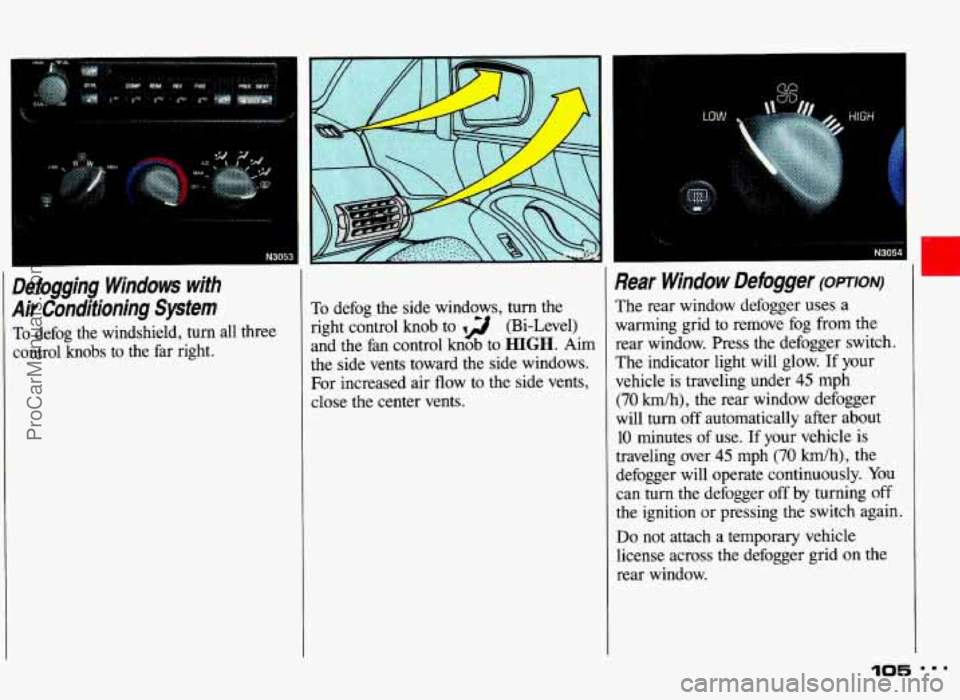
I
Defogging Windows with
Air Conditioning System
To defog the windshield, turn all three
control knobs to the far right. To defog
the side windows, turn the
right control knob to 12 (Bi-Level)
and the fan control knob to
HIGH. Aim
the side vents toward the side windows.
For increased air flow to the side vents,
close the center vents.
Rear Window Defogger (OPTION)
The rear window defogger uses a
warming grid to remove fog from the
rear window. Press
the defogger switch.
The indicator light will glow.
If your
vehicle is traveling under
45 mph
(70 kmlh), the rear window defogger
will turn off automatically after about
10 minutes of use. If your vehicle is
traveling over
45 mph (70 km/h), the
defogger will operate continuously. You
can
turn the defogger off by turning off
the ignition or pressing the switch again.
Do not attach a temporary vehicle
license across the defogger grid
on the
rear window.
105 ...
................. * N3054
ProCarManuals.com
Page 122 of 306
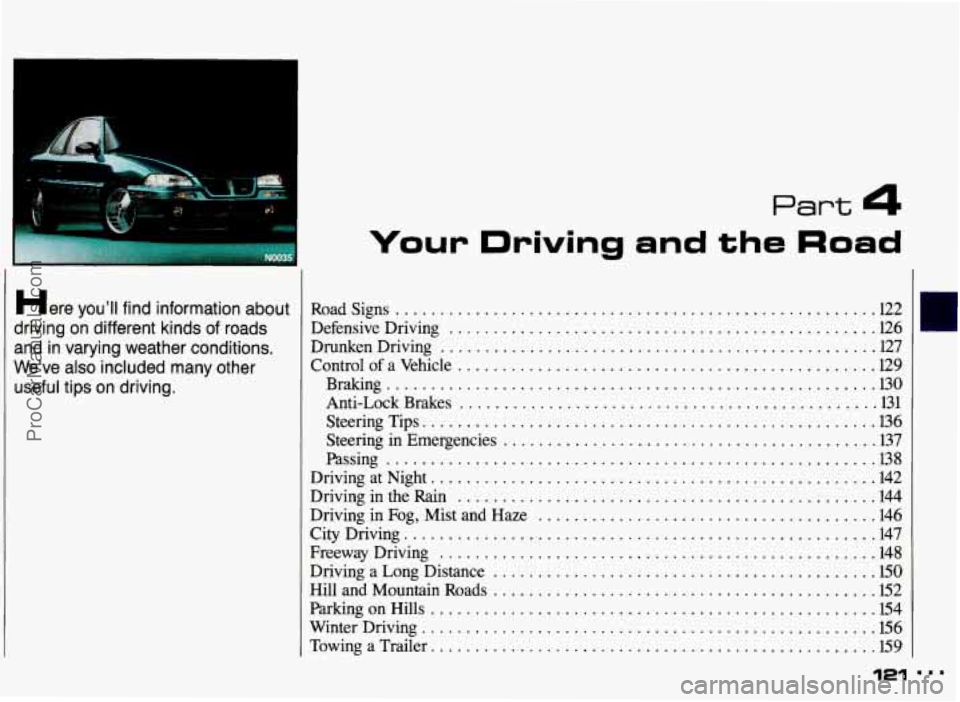
Part 4
Your Driving and the Road
Here you’ll find information about
driving on different kinds of roads
and in varying weather conditions
.
We’ve also included many other
useful tips on driving
.
Roadsigns ...................................................... 122
Defensive Driving ................................................ 126
Drunken Driving ................................................. 127
Control of a Vehicle ............................................... 129
Steering Tips
................................................... 136
Steering in Emergencies .......................................... 137
DrivingatNight
.................................................. 142
Driving in the Rain
............................................... 144
Driving in
Fog, Mist and Haze ...................................... 146
Freeway Driving
................................................. 148
Driving a Long Distance ........................................... EO
Hill and Mountain Roads ........................................... 152
ParkingonHills .................................................. 154
Winter Driving
................................................... E6
Towing a Trailer ..................... ......................... 159
Braking
....................................................... 130
Anti-LockBrakes
............................................... 131
Passing
....................................................... 138
CityDriving ..................................................... 147
121
ProCarManuals.com
Page 127 of 306
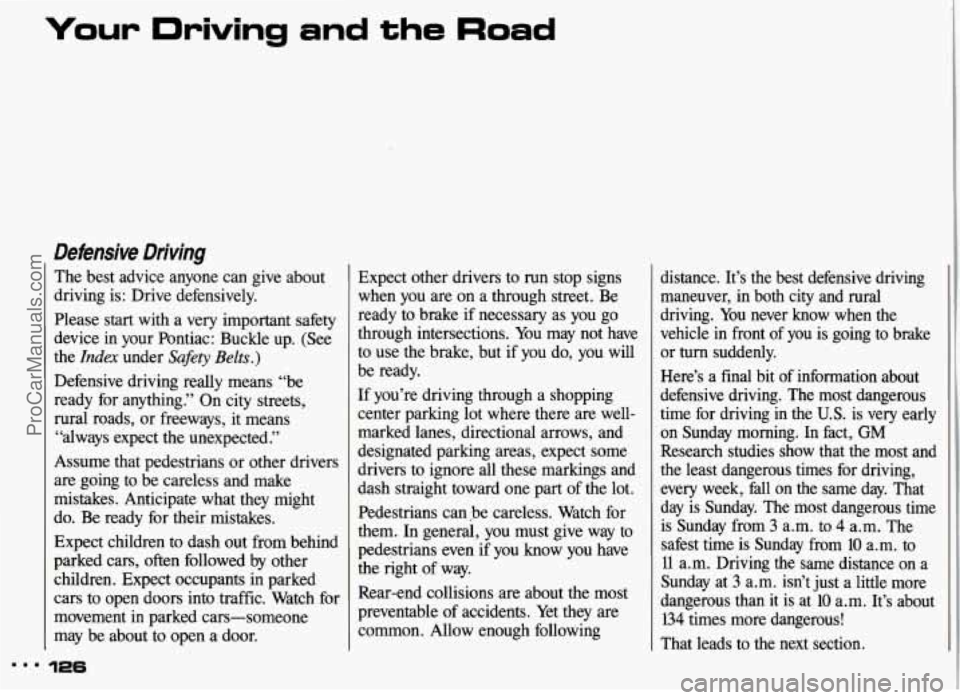
Defensive Driving
The best advice anyone can give about
driving is: Drive defensively.
Please start with a very important safety
device in your Pontiac: Buckle up. (See
the
Index under Safety Belts.)
Defensive driving really means “be
ready for anything.” On city streets,
rural roads, or freeways, it means
“always expect the unexpected
.”
Assume that pedestrians or other drivers
are going to be careless and make
mistakes. Anticipate what they might
do. Be ready for their mistakes.
Expect children to dash out from behind
parked cars, often followed
by other
children. Expect occupants in parked
cars to open doors into traffic. Watch for
movement in parked cars-someone
may be about to open a door.
126
Expect other drivers to run stop signs
when you are on a through street. Be
ready to brake if necessary as you go
through intersections. You may not have
to use the brake, but if you do, you will
be ready.
If you’re driving through a shopping
center parking lot where there are well-
marked lanes, directional arrows, and
designated parking areas, expect some
drivers to ignore all these markings and
dash straight toward one part of the lot.
Pedestrians canbe careless. Watch for
them.
In general, you must give way to
pedestrians even if you know you have
the right of way.
Rear-end collisions are about the most
preventable of accidents. Yet they are
common. Allow enough following distance. It’s the best defensive driving
maneuver, in both city and rural
driving. You never know when the
vehicle in front
of you is going to brake
or
turn suddenly.
Here’s a final bit of information about
defensive driving. The most dangerous
time for driving in the
U.S. is very early
on Sunday morning. In fact, GM
Research studies show that the most and
the least dangerous times for driving,
every week, fall on the same day. That
day is Sunday. The most dangerous time is Sunday from
3 a.m. to 4 a.m. The
safest time is Sunday from
10 a.m. to
11 a.m. Driving the same distance on a
Sunday at
3 a.m. isn’t just a little more
dangerous than it is at
10 a.m. It’s about
134 times more dangerous!
That leads to the next section.
ProCarManuals.com
Page 150 of 306

Driving on the Freeway
Once you are on the freeway, adjust
your speed to the posted
limit or to the
prevailing rate if it’s slower. Stay in the
right lane unless
you want to pass. If
you are on a two-lane freeway, treat the
right lane as the slow lane and the left
lane as the passing lane.
If you are on a three-lane freeway, treat
the right lane as the slower-speed
through lane, the middle lane as the
higher-speed through lane, and the left lane as the passing lane.
Before changing lanes, check your rearview mirrors. Then use your
turn
signal. Just before you leave the lane,
glance quickly over your shoulder to
make sure there isn’t another vehicle in
your “blind” spot. If you
are moving from an outside to a
center lane on a freeway having more
than two lanes, make sure another
vehicle isn’t about to move into the same
spot. Look at the vehicles two lanes
over and watch for telltale signs: turn
signals flashing, an increase in speed, or
moving toward the edge
of the lane. Be
prepared to delay your move.
Once you are moving on the freeway,
make certain you allow a reasonable
following distance. Expect to move
slightly slower at night.
leaving the Freeway
When you want to leave the freeway,
move to the proper lane well
in advance.
Dashing across lanes at the last minute
is dangerous. If you miss your exit do
not, under any circumstances, stop and
back up. Drive on to the next exit.
At each exit point is a deceleration lane.
Ideally it should be long enough for you
to enter it at freeway speed (after
signaling,
of course) and then do your
braking before moving onto the exit
ramp. Unfortunately, not
all deceleration
lanes are long enough-some are too
short for all the braking. Decide when
to start braking.
If you must brake on
the through lane, and if there is traffic
close behind you, you can allow a little
ProCarManuals.com
Page 154 of 306
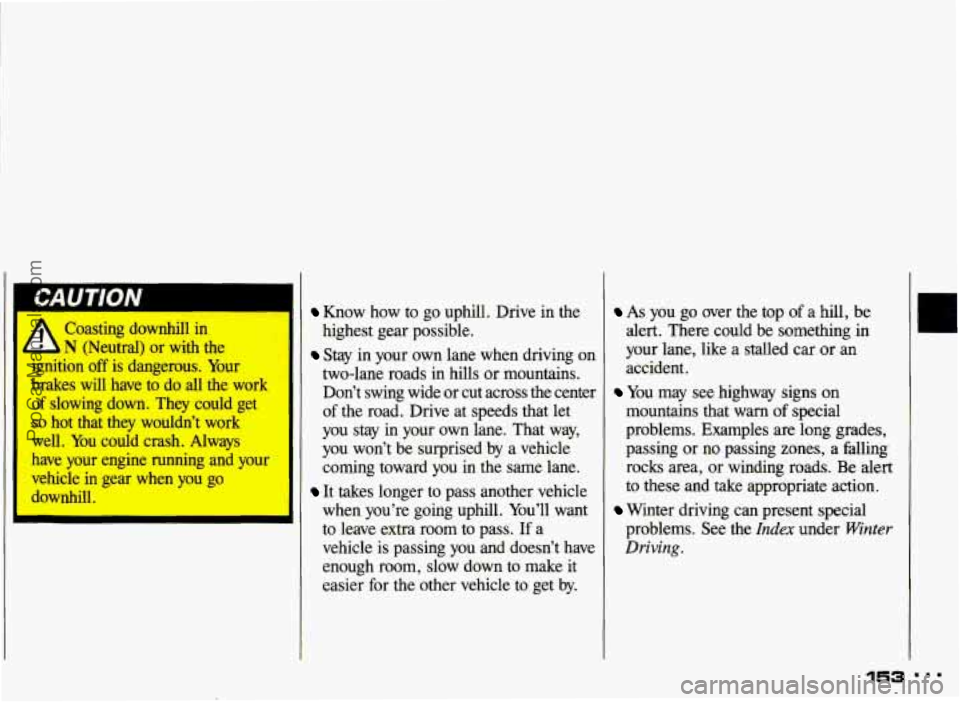
CAUTION
A
Coasting downhill in
N (Neutral) or with the
ignition
off is dangerous. Your
brakes will have to do all the work
of slowing down. They could get
so hot that they wouldn’t work
well. You could crash. Always
have your engine running and your
vehicle in gear when you go
downhill.
Know how to go uphill. Drive in the
highest gear possible.
Stay in your own lane when driving on
two-lane roads in hills or mountains.
Don’t swing wide or cut across the center
of the road. Drive at speeds that let
you stay in your own lane. That way,
you won’t be surprised by a vehicle
coming toward you
in the same lane.
It takes longer to pass another vehicle
when you’re going uphill. You’ll want
to leave extra room to pass. If a
vehicle
is passing you and doesn’t have
enough room, slow down to make it
easier- for the other vehicle to get by.
As you go over the top of a hill, be
alert. There could be something in
your lane, like a stalled
car or an
accident.
You may see highway signs on
mountains that warn of special
problems. Examples are long grades,
passing or no passing zones, a falling
rocks area, or winding roads.
Be alert
to these and take appropriate action.
problems. See the
Index under Winter
Driving.
Winter driving can present special
153
ProCarManuals.com
Page 160 of 306
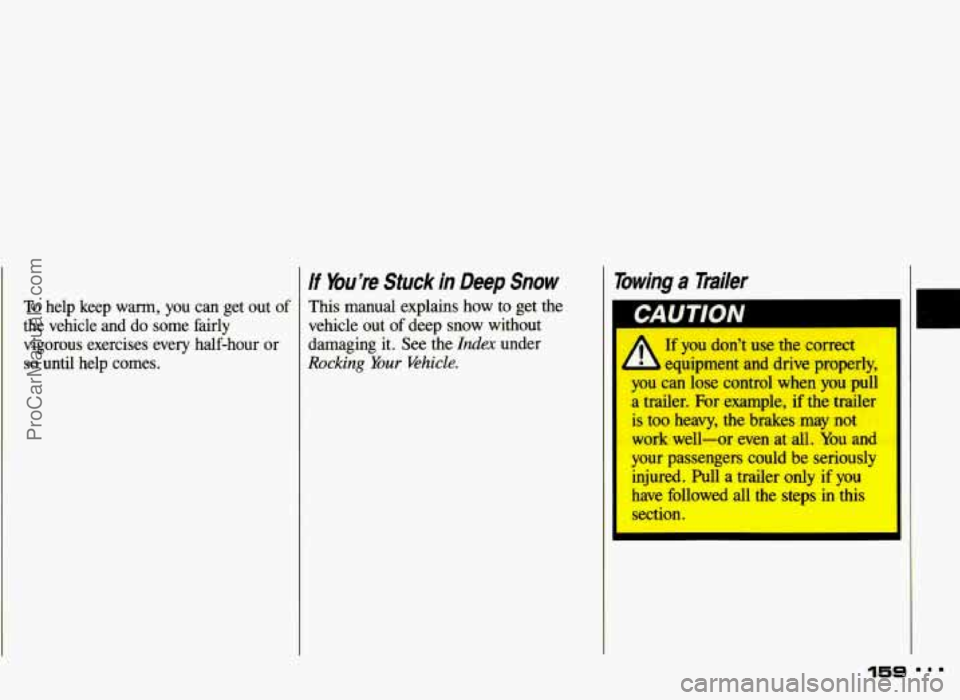
To help keep warm, you can get out of
the vehicle and do some fairly
vigorous exercises every half-hour or
so until help comes.
If You're Stuck in Deep Snow
This manual explains how to get the
vehicle out of deep snow without
damaging it. See the
Index under
Rocking Your Ehicle.
Towing a nailer
A
If you don't use the correct
equipment and drive properly,
you can lose control when you pull
a trailer. For example, if the trailer
is too heavy, the brakes may not
work well-or even at
all. You and
your passengers could be seriously
injured. Pull a trailer
only if you
have followed all the steps in
this
section.
I
ProCarManuals.com
Page 161 of 306
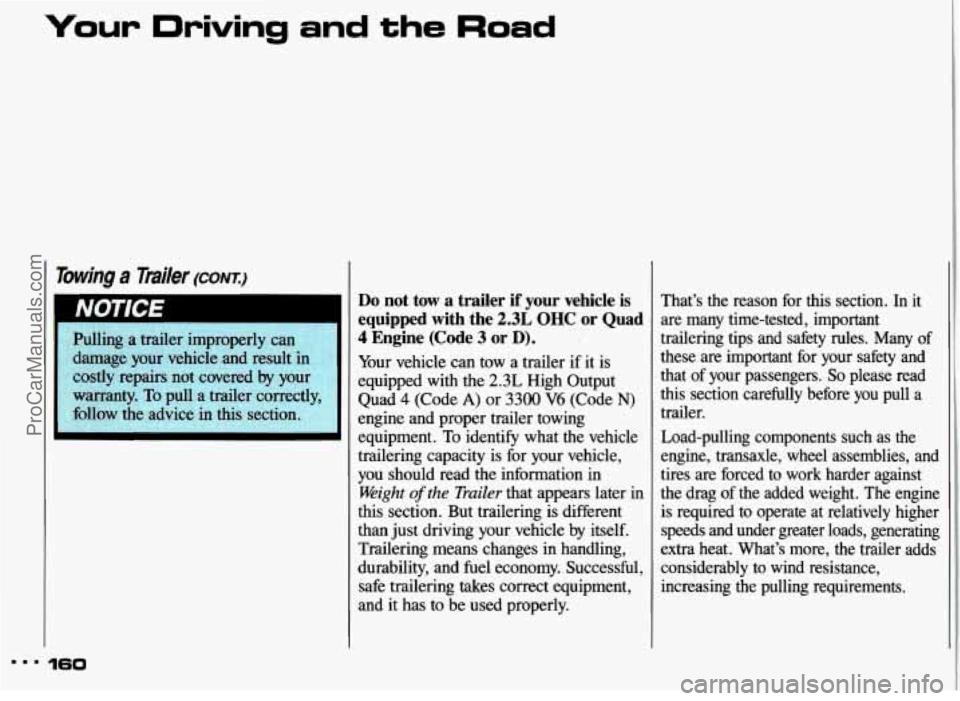
Your Driving and the Road
Towing a mailer (CONTJ
Pulling a trailer improperly can :i+-a .,, >
damage your vehicle and result inf. i,$i
costly repairs not covered by you$.<; .:
warranty. To pull a trailer correct&$; ’:
follow the advice in this section. ,,
’ ,,, . .
, , :i!
Do not tow a trailer if your vehicle is
equipped with the
2.3L OHC or Quad
4 Engine (Code 3 or D).
Your vehicle can tow a trailer if it is
equipped with the
2.3L High Output
Quad
4 (Code A) or 3300 V6 (Code N)
engine and proper trailer towing
equipment. To identify what the vehicle
trailering capacity is for your vehicle,
you should read the information
in
Weight of the Trailer that appears later in
this section. But trailering is different
than just driving your vehicle by itself.
Trailering means changes in handling,
durability, and fuel economy. Successful, safe trailering
takes correct equipment,
and it has to be used properly. That’s the reason for this section.
In it
are many time-tested, important
trailering tips and safety rules. Many
of
these are important for your safety and
that of your passengers.
So please read
this section carefully before you pull a
trailer.
Load-pulling components such as the
engine, transaxle, wheel assemblies, and
tires are forced to work harder against
the drag
of the added weight. The engine
is required to operate at relatively higher
speeds and under greater loads, generating
extra heat. What’s more, the trailer adds
considerably to wind resistance,
increasing the pulling requirements.
... 160
ProCarManuals.com
Page 162 of 306
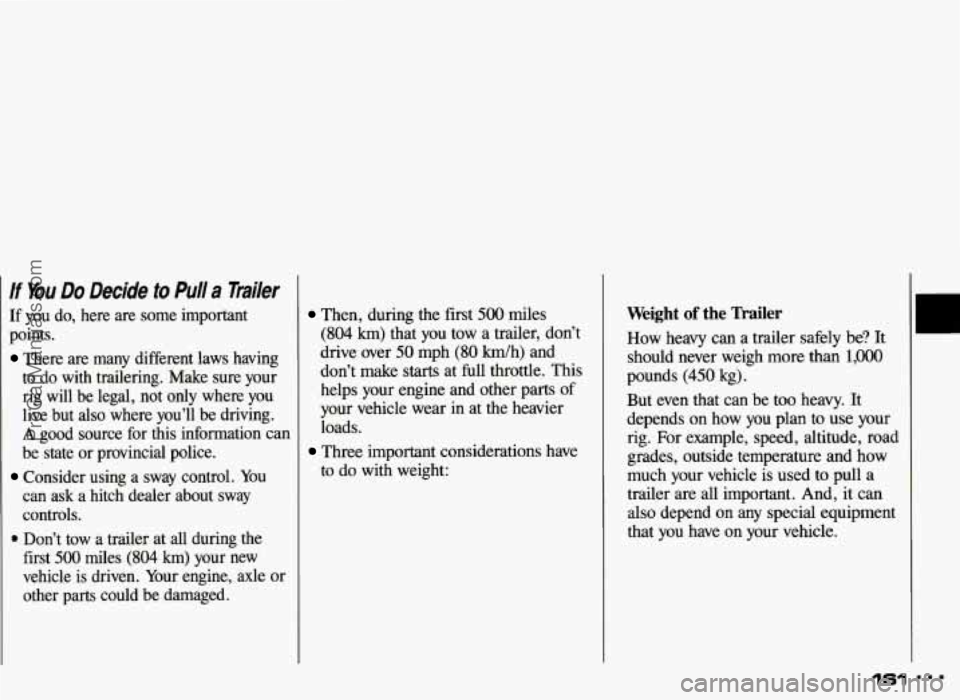
If Bu Do Decide to Pull a Trailer
If you do, here are some important
points.
There are many different laws having
to do with trailering. Make sure your rig will be legal, not only where you
live but
also where you’ll be driving.
A good source for this information can
be state or provincial police.
Consider using a sway control. You
can ask a hitch dealer about sway
controls.
a Don’t tow a trailer at all during the
first
500 miles (804 km) your new
vehicle is driven. Your engine, axle or
other parts could
be damaged.
Then, during the first 500 miles
(804
km) that you tow a trailer, don’t
drive over
50 mph (80 km/h) and
don’t make
starts at full throttle. This
helps your engine and other parts of
your vehicle wear in at the heavier
loads.
Three important considerations have
to do with weight:
161
I. Weight of the Trailer
How heavy can a trailer safely be? It
should never weigh more than
1,OOO
pounds (450 kg).
But even that can be too heavy. It
depends on how you plan to use your
rig. For example, speed, altitude, road
grades, outside temperature and how
much your vehicle is used to pull a
trailer are
all important. And, it can
also depend on any special equipment
that you have
on your vehicle.
...
ProCarManuals.com